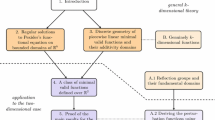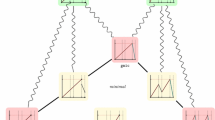Abstract
We investigate three competing notions that generalize the notion of a facet of finite-dimensional polyhedra to the infinite-dimensional Gomory–Johnson model. These notions were known to coincide for continuous piecewise linear functions with rational breakpoints. We show that two of the notions, extreme functions and facets, coincide for the case of continuous piecewise linear functions, removing the hypothesis regarding rational breakpoints. We prove an if-and-only-if version of the Gomory–Johnson Facet Theorem. Finally, we separate the three notions using discontinuous examples.





Similar content being viewed by others
Notes
The command h = hildebrand_discont_3_slope_1(); extremality_test(h) carries out the verification.
The enumeration is done by the function generate_faces_with_projections_intersecting. A fully automatic verification is carried out by the command kzh_minimal_has_only_crazy_perturbation_1_check_subadditivity_slacks().
The authors thank Jiawei Wang for his help with implementing this function in the software.
References
Basu, A., Conforti, M., Cornuéjols, G., Zambelli, G.: A counterexample to a conjecture of Gomory and Johnson. Math. Program. Ser. A 133(1–2), 25–38 (2012). https://doi.org/10.1007/s10107-010-0407-1
Basu, A., Conforti, M., Di Summa, M., Paat, J.: The structure of the infinite models in integer programming. In: Integer Programming and Combinatorial Optimization: 19th International Conference, IPCO 2017, Waterloo, ON, Canada, June 26–28, 2017, Proceedings (F. Eisenbrand and J. Koenemann, eds.), Springer International Publishing, Cham, pp. 63–74 (2017). https://doi.org/10.1007/978-3-319-59250-3_6, ISBN 978-3-319-59250-3
Basu, A., Hildebrand, R., Köppe, M.: Equivariant perturbation in Gomory and Johnson’s infinite group problem. I. The one-dimensional case. Math. Oper. Res. 40(1), 105–129 (2014). https://doi.org/10.1287/moor.2014.0660
Basu, A., Hildebrand, R., Köppe, M.: Light on the infinite group relaxation I: foundations and taxonomy. 4OR 14(1), 1–40 (2016). https://doi.org/10.1007/s10288-015-0292-9
Basu, A., Hildebrand, R., Köppe, M.: Light on the infinite group relaxation II: sufficient conditions for extremality, sequences, and algorithms. 4OR 14(2), 107–131 (2016). https://doi.org/10.1007/s10288-015-0293-8
Basu, A., Hildebrand, R., Köppe, M.: Equivariant perturbation in Gomory and Johnson’s infinite group problem–III: Foundations for the \(k\)-dimensional case with applications to \(k=2\). Math. Program. 163(1), 301–358 (2017). https://doi.org/10.1007/s10107-016-1064-9
Basu, A., Hildebrand, R., Köppe, M., Molinaro, M.: A \((k+1)\)-slope theorem for the \(k\)-dimensional infinite group relaxation. SIAM J. Optim. 23(2), 1021–1040 (2013). https://doi.org/10.1137/110848608
Conforti, M., Cornuéjols, G., Zambelli, G.: Corner polyhedra and intersection cuts. Surv. Oper. Res. Manag. Sci. 16, 105–120 (2011)
Conforti, M., Cornuéjols, G., Zambelli, G.: Integer Programming. Springer, Cham (2014). https://doi.org/10.1007/978-3-319-11008-0. ISBN 978-3-319-11007-3
Dey, S.S.: Strong Cutting Planes for Unstructured Mixed Integer Programs Using Multiple Constraints. Ph.D. Thesis, Purdue University, West Lafayette, Indiana, (2007). http://search.proquest.com/docview/304827785, ISBN 9780549303756
Dey, S.S., Richard, J.-P.P.: Facets of two-dimensional infinite group problems. Math. Oper. Res. 33(1), 140–166 (2008). https://doi.org/10.1287/moor.1070.0283
Dey, S.S., Richard, J.-P.P., Li, Y., Miller, L.A.: On the extreme inequalities of infinite group problems. Math. Program. 121(1), 145–170 (2010). https://doi.org/10.1007/s10107-008-0229-6
Gomory, R.E., Johnson, E.L.: Some continuous functions related to corner polyhedra, I. Math. Program. 3, 23–85 (1972). https://doi.org/10.1007/BF01584976
Gomory, R.E., Johnson, E.L.: Some continuous functions related to corner polyhedra, II. Math. Program. 3, 359–389 (1972). https://doi.org/10.1007/BF01585008
Gomory, R.E., Johnson, E.L.: T-space and cutting planes. Math. Program. 96, 341–375 (2003). https://doi.org/10.1007/s10107-003-0389-3
Hildebrand, R., Köppe, M., Zhou, Y.: On perturbation spaces of minimal valid functions: inverse semigroup theory and equivariant decomposition theorem. In: Integer Programming and Combinatorial Optimization. IPCO 2019 (A. Lodi and V. Nagarajan, eds.), Lecture Notes in Computer Science, vol. 11480, pp. 247–260. Springer, Cham (2019). https://doi.org/10.1007/978-3-030-17953-3_19, ISBN 978-3-030-17952-6
Hildebrand, R., Köppe, M., Zhou, Y.: Equivariant perturbation in Gomory and Johnson’s infinite group problem. VII. Inverse semigroup theory, closures, decomposition of perturbations. e-print (2020) arXiv:1811.06189
Hong, C.Y., Köppe, M., Zhou, Y.: Equivariant perturbation in Gomory and Johnson’s infinite group problem (V). Software for the continuous and discontinuous 1-row case. Optim. Methods Softw. 33(3), 475–498 (2018). https://doi.org/10.1080/10556788.2017.1366486
Köppe, M., Zhou, Y.: Equivariant perturbation in Gomory and Johnson’s infinite group problem. VI. The curious case of two-sided discontinuous minimal valid functions. Discrete Optim. 30, 51–72 (2018). https://doi.org/10.1016/j.disopt.2018.05.003
Köppe, M., Zhou, Y., Hong, C.Y., Wang, J.: Cutgeneratingfunctionology: Python code for computation and experimentation with cut-generating functions, https://github.com/mkoeppe/cutgeneratingfunctionology (November 2019) (Version 1.4.1). https://doi.org/10.5281/zenodo.3552781
Richard, J.-P.P., Dey, S.S.: The group-theoretic approach in mixed integer programming. In: Jünger, M., Liebling, T.M., Naddef, D., Nemhauser, G.L., Nemhauser, W.R., Reinelt, G., Wolsey, L.A. (eds.) 50 Years of Integer Programming 1958–2008, pp. 727–801. Springer, Berlin (2010). https://doi.org/10.1007/978-3-540-68279-0_19. ISBN 978-3-540-68274-5
Schrijver, A.: Theory of Linear and Integer Programming. John Wiley and Sons, New York (1986)
Zhou, Y.: Infinite-Dimensional Relaxations of Mixed-Integer Optimization Problems. Ph.D. Thesis, University of California, Davis, Graduate Group in Applied Mathematics, (May 2017). https://search.proquest.com/docview/1950269648
Acknowledgements
The authors wish to thank the anonymous referees for their numerous detailed suggestions, which have been very valuable in improving the presentation of our results.
Author information
Authors and Affiliations
Corresponding author
Additional information
Publisher's Note
Springer Nature remains neutral with regard to jurisdictional claims in published maps and institutional affiliations.
The authors gratefully acknowledge partial support from the National Science Foundation through Grant DMS-1320051, awarded to M. Köppe. A preliminary version appeared in Chapter 6 of the second author’s Ph.D. thesis Infinite-dimensional relaxations of mixed-integer optimization problems, University of California, Davis, Graduate Group in Applied Mathematics, May 2017, available from https://search.proquest.com/docview/1950269648. An extended abstract appeared in: M. Köppe and Y. Zhou, On the notions of facets, weak facets, and extreme functions of the Gomory–Johnson infinite group problem, Integer Programming and Combinatorial Optimization: 19th International Conference, IPCO 2017, Waterloo, ON, Canada, June 26–28, 2017, Proceedings (Friedrich Eisenbrand and Jochen Koenemann, eds.), Springer International Publishing, Cham, 2017, pp. 330–342, https://doi.org/10.1007/978-3-319-59250-3_27, ISBN 978-3-319-59250-3.
Appendices
Appendix A: Auxiliary result
In the proof of Theorem 3.1, we need the following elementary geometric estimate.
Lemma A.1
Let \(F \subset [0,1]^2\) be a convex polygon with vertex set \({{\,\mathrm{vert}\,}}(F)\), and let \(g:F \rightarrow {\mathbb {R}}\) be an affine linear function. Suppose that for each \(v \in {{\,\mathrm{vert}\,}}(F)\), either \(g(v) = 0\) or \(g(v) \ge m\) for some \(m > 0\). Let \(S = \{\,x \in F\mid g(x) = 0\,\}\), and assume that S is nonempty. Then \(g(x) \ge m\,d(x, S)/2\) for any \(x \in F\), where d(x, S) denotes the Euclidean distance from x to S.
Proof
Let \(x \in F\) be arbitrary. We may write
for some \(\alpha _v \in [0,1]\) with \(\sum _v \alpha _v = 1\).
Since S is a closed set, for each \(v \in {{\,\mathrm{vert}\,}}(F)\), there exists \(s_v \in S\) such that \(d(v,S)=d(v, s_v)\). Let \(s^* = \sum _{v \in {{\,\mathrm{vert}\,}}(F)} \alpha _v s_v\). We have that \(s^* \in S\) since the set S is convex. Thus,
For those \(v \in {{\,\mathrm{vert}\,}}(F)\) with \(g(v) = 0\), we have \(v \in S\) by definition and thus \(d(v,S) = 0\). Therefore,
Using the affine linearity of g, it thus follows that
\(\square \)
Appendix B: Data of the function \(\pi \,{=}\,\) kzh_minimal_has_only_crazy_perturbation_1()
The following pages provide tables with data of the piecewise linear function \(\pi =\textsf {kzh\_minimal\_has\_only\_crazy\_perturbation\_1()}\) of Theorem 6.2.
Table 1 defines the function by listing the breakpoints \(x_i\) and the values and the left and right limits at the breakpoints. (A version of this table has previously appeared in [19].)
Tables 2 and 3 list the faces \(F = F(I, J, K)\) of the complex \(\varDelta \mathcal {P}\) that we use for proving piecewise linearity of \({{\bar{\pi }}}\) outside of the special intervals, i.e., Claim (o) in the proof of Theorem 6.2. In all tables, the faces are listed by lexicographically increasing triples (I, J, K); and of the two equivalent faces F(I, J, K) and F(J, I, K), we only show the lexicographically smaller one.
Table 4 shows a list of faces F that satisfy \(\varDelta {{\bar{\pi }}}_F(x,y)=0\) for all \((x, y) \in {{\,\mathrm{rel\,int}\,}}(F)\). This property can be verified by inspecting the provided list of vertices of each face. A selection of one vertex (u, v) for each listed face F, listed first in the table, suffices to form a full-rank homogeneous linear system of equations \(\varDelta {{\bar{\pi }}}_F(u, v) = 0\). We obtained the selection of faces and their vertices by Gaussian elimination. The full-rank system, shown in Table 5, proves that \({{\bar{\pi }}}\) is 0 outside of the special intervals, Claim (i) in the proof of Theorem 6.2.
Finally, Tables 6 and 7 list the faces F whose projections \(p_i({{\,\mathrm{rel\,int}\,}}(F))\), \(i=1,2,3\), overlap with the special intervals (\(n_F>0\)). They are relevant for verifying Claims (ii), (iii), and (vi) in the proof of Theorem 6.2. For each face F, we list the values of the subadditivity slack \(\varDelta \pi _F(u, v)\) for all vertices (u, v) of F in nondecreasing order from left to right. If there is an enclosing face \(F'\supset F\) with \(\varDelta \pi _{F'}(u, v) = \varDelta \pi _F(u,v)\) for all vertices (u, v) of F because of one-sided continuity, then we suppress F in the table.
All numbers have been rounded to 3 decimals for presentation. Claims (ii) and (iii) use faces with \(\varDelta \pi _F(x,y) = 0\) for \((x, y)\in F\). To verify Claim (v), note that if \(\varDelta \pi _F(u,v)=0\) for one vertex of F, then \(\varDelta \pi _F(u,v)=0\) for all vertices of F. Next, note that for all other faces F with \(n_F>0\), the inequality \(\varDelta \pi _F(u,v) \ge n_F\cdot s\) (where \(s \approx 0.001\)) is satisfied and tight for at most one vertex (u, v) of each face. These vertices are marked by the word “(tight)” in the tables; we have \(n_F=1\) for each of these faces. All remaining subadditivity slacks \(\varDelta \pi _F(u,v)\) for vertices \((u, v)\in {{\,\mathrm{vert}\,}}(F)\) exceed \(0.003 \ge 3\cdot s\).
Rights and permissions
About this article
Cite this article
Köppe, M., Zhou, Y. Facets, weak facets, and extreme functions of the Gomory–Johnson infinite group problem. Math. Program. 187, 195–252 (2021). https://doi.org/10.1007/s10107-020-01477-2
Received:
Accepted:
Published:
Issue Date:
DOI: https://doi.org/10.1007/s10107-020-01477-2




